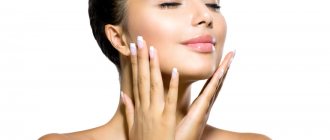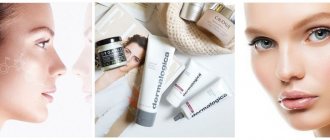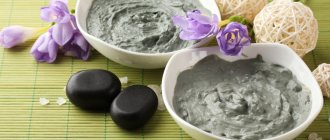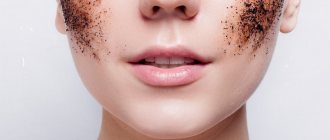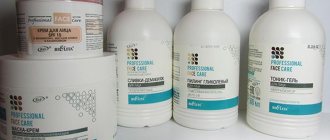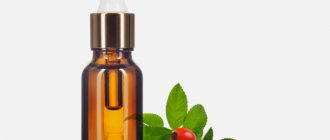Vitamin E or tocopherol is the most beneficial substance for the face. Even more: it is one of the main vitamins in cosmetology. Surely you also have some kind of facial product with tocopherol, but what do you know about it?
In general, there is not just one tocopherol, it is a whole group of similar substances. They are united by the ability to destroy free radicals, aggressive elements that accelerate cell aging and damage them. Previously, vitamin E was isolated from wheat germ, now it is mainly from soybean and sunflower oils.
In cosmetics, vitamin E can be designated as follows:
- Tocopherol acetate;
- Tocopherol succinate;
- Tocopherol nicotinate;
- Tocopherol linoleate.
What is vitamin E for?
One of the vital vitamins, the deficiency of which leads to systemic disorders in the body. It belongs to the fat-soluble category and is more fully absorbed in combination with vitamins A, C, D, zinc and selenium. It has a pronounced antioxidant property: it inhibits oxidation processes, prevents damage to healthy cells by decay products.
Vitamin E regulates the processes of tissue restoration of the skin, mucous membranes, internal organs, the production of collagen, hormones, and amino acid metabolism. Its normal level ensures timely tissue regeneration, protection from excessive ultraviolet radiation, exposure to carcinogenic substances, premature aging, normal functioning of the reproductive system, and hematopoiesis.
Masks
The most popular way to use vitamin E is as a face mask. When mixed with other components, tocopherol acts even more effectively. We offer you homemade recipes for face masks with vitamin E.
After any mask, you need to thoroughly wash your face and use a toner to even out the pH of the skin. When the skin is dry, seal the result with moisturizer. Just not with vitamin E, otherwise there will be an overdose! So…
Oatmeal mask
cleanses the face, gives it a healthy color and moisturizes. Grind 2 tbsp. l. rolled oats, add 5 drops of cosmetic vitamin E and a teaspoon of lemon juice. Leave the mixture on the skin for 20 minutes, then rinse off.
Curd mask
ideal for dry skin with wrinkles. Moisturizes, nourishes and smoothes. Take 2 tablespoons of low-fat cottage cheese, 3 tea olive oils and 5 drops of vitamin E. Mix, preferably in a blender, and apply to your face for 20 minutes.
Banana mask
perfectly tightens and awakens tired and aging skin. Also evens out complexion. Mix ripe banana pulp with 2 tbsp. l. cream and 5 drops of tocopherol. Mix thoroughly and leave the mixture on the skin for 20 minutes.
Honey mask
. When combined with natural honey, vitamin E has a powerful exfoliating effect. Therefore, such a mask can serve as a peeling. Mix the yolk, a teaspoon of honey and 10 drops of tocopherol. Apply for 20 minutes, then rinse.
Coconut mask
. There are many recipes for “vitamin E + vegetable oil” face masks, but we chose coconut. Coconut oil is widely used in cosmetology; it has many beneficial properties. Mix 2 tsp. liquid coconut oil with 20 g of yeast and 1 capsule of tocopherol. Leave it on for half an hour and wash it off.
Mask A+E
. In home cosmetology, vitamin E is often used together with retinol and vitamin A. This is also a powerful antioxidant. Buy the drug "Aevit": 1 capsule is enough for 1 mask. You can mix “Aevit” with honey, yolk and olive oil.
Eye mask
. Vitamin E will also be beneficial for the skin around the eyes. It is thinner and more sensitive, and wrinkles earlier than the rest of the face. The mask is very simple: mix 10 ml of vitamin E with olive oil and apply to the skin of the eyelids. After 20 minutes, gently wipe off with a cotton pad.
You can make such face masks with vitamin E once every 2-3 days. After a month, take a break, otherwise hypervitaminosis will occur. Refrain from tocopherol therapy for a couple of months.
To enhance the effect of a mask with vitamin E, apply it to pre-steamed skin. To do this, you can put a hot towel on your face or take a steam bath. Opened pores will make the skin more receptive to active substances.
Symptoms of Vitamin E Deficiency
Hypovitaminosis in childhood causes the development of dermatitis, rickets and decreased vision. Long-term deficiency slows down the development of speech, provokes anemia, neurological disorders: coordination of movements, attention.
In adults, the condition of the skin and hair worsens, inflammatory and endocrine diseases occur more often, the cardiovascular system suffers, fertility decreases, women experience menstrual irregularities, and premenstrual syndrome is severe. With severe hypovitaminosis, hormonal imbalance, infertility, and signs of early aging develop. If a vitamin E deficiency is detected, in addition to correcting the diet, it is necessary to take special pharmaceuticals.
Use of vitamin E: rules and indications
Our task is to learn how to get the maximum benefit from this biologically active substance. If treated correctly, it will transform our face, make its contours tightened, and the skin elastic and healthy.
Most often, tocopherol in capsules (in the form of oil) or in creams is used to affect the area around the eyes, which is extremely sensitive. I recommend not to get carried away with products you prepare yourself - only a professional knows the required dosage, as well as the optimal combination of active ingredients. I advise you to pay attention to liposomal cosmetics that carefully and effectively care for your skin.
Who needs vitamin E in all its forms?
- For everyone over 30 years old – prevention of premature aging and protection from the negative influence of the environment.
- For those over forty, tocopherol eliminates facial wrinkles, evens out complexion, eliminating age spots and dark circles under the eyes.
- For those who are concerned about the loss of tone and elasticity, vitamin E returns moisture to the epidermal cells, saving dehydrated areas, and gives a healthy appearance to even dull, aging and sensitive skin.
Tocopherol is sold in several forms. Before choosing one of them, carefully read the description that I will give below for each of the forms. Don't forget that in most cases you can get by with purchasing professional cosmetics created by experts for your beauty and health.
How to take vitamin E correctly
When administered orally, capsules with alpha-tocopherol are swallowed whole without crushing. Drink with enough water. Recommended time of administration is during meals. It is advisable to include foods rich in vitamin E in your diet.
The treatment regimen is individual, depending on the physical condition and age. For prevention, adults are recommended to take 400 mg. vitamin per day. The course of therapy depends on the type of disorder present. It is recommended to take the vitamin cyclically: daily for several weeks, with repeat treatment after a break.
The drug does not affect the ability to drive vehicles and complex equipment, does not cause drowsiness, decreased performance, or changes in the speed of psychomotor reactions.
Rubbing into skin
The second way to use vitamin E is externally, and we’ll start by rubbing it into the skin of the face. To do this, buy vitamin E: it is found in the form of an oil solution (at the pharmacy) and in its pure form (cosmetic solution). The cosmetic solution is, of course, more concentrated. And more expensive.
It is not prohibited to use vitamin E in its pure form on the face; the main thing is to maintain safe dosages. If you overdo it, you can provoke itching and allergies, rashes and red spots. It follows from this that only a small amount of concentrate will be used.
This means that rubbing pure tocopherol makes sense if there are local problems on the face. For example, rashes, deep wrinkles, peeling. A safe amount of pure vitamin E is simply not enough for the entire face.
Therefore, most often vitamin E is added somewhere. Either in store-bought cosmetics or in homemade mixtures. Moreover, there are no substances incompatible with tocopherol: it is extremely stable.
Applying liquid vitamin to face
Many users doubt whether it is useful to smear the face with tocopherol in its pure structural form. But from a pharmacological point of view, the vitamin contained in ampoules and capsules cannot be called a pure substance; it is a component of the oil preparation. The active substance dissolved in oil is well absorbed into the skin and acts effectively. Therefore, oil-based tocopherol can be safely used for cosmetic purposes.
The vitamin can be used in two main ways.
- The most primitive way is to simply rub the drug into the skin. The treatment is carried out with soft, careful massage movements with fingers patting the face. You should not use a lot of solution; 2 capsules are enough to treat your face.
- The second application option is to add the substance to the cream. It is advisable to use deeply nourishing night cosmetics. When caring for thin eyelid skin, it is recommended to pour liquid tocopherol into special masks.
Other acne treatments
- Salicylic Acid: This beta hydroxy acid (BHA) breaks down cellular compounds to stimulate natural exfoliation and prevent acne formation. It is best for mild acne (whiteheads and blackheads).
- Alpha Hydroxy Acids: Ahasexfoliates the skin to reduce formation. They minimize visible flaking, improve cell turnover and reduce the appearance of acne scars.
- Tea Tree Oil: Has antimicrobial and anti-inflammatory properties that minimize acne-causing bacteria and reduce the severity of acne lesions.
- Benzoyl Peroxide: Has antibacterial properties that reduce blackheads and acne lesions. However, it can irritate the skin if not used in proper concentrations. Check with your doctor before using benzoyl peroxide.
- Sulfur: Acts as a keratolytic (exfoliating) agent and is often used to soothe acne and seborrheic dermatitis.
- Retinoic acid: This metabolite of vitamin A is also known as tretinoin and is often used to treat acne. Using retinoic acid with glycolic acid (AHA) has been found to improve acne scarring.
However, all skin types may react poorly to these medications. Consult with your doctor to determine which ingredient may be appropriate for your skin at what concentration.
Before introducing a new ingredient into your skin, take proper care of it. This is the best way to avoid any complications.
What you need to know before mixing
Photo by cottonbro: Pexels
Not all vitamins are equally useful, and not all creams can survive interference with their composition. If in doubt, it is better not to add foreign substances to the jar of cream, but to mix a small amount at a time directly in your hands. This way the formula will remain stable, the cream will definitely not deteriorate, and you will get the expected effect from using vitamins for the skin.
Keep the cheat sheet:
- Vitamin E (tocopheryl acetate) is a preservative and is added to cosmetics to stabilize the formula.
You can safely add this substance directly to the jar of cream - it will not affect the shelf life and properties of the formula.
- Vitamin A works in tandem with vitamin E, so you can add a few milligrams directly to the jar in addition to the tocopherol. But this vitamin can accumulate in the skin, so don’t overdo it.
- Vitamin C is unstable, no matter the formula. Both ascorbic acid powder and the solution from the ampoule quickly lose their properties in the light and upon contact with oxygen. It will not work in a jar of cream, it is better to mix before use.
- B vitamins behave unpredictably in tandem with other assets in your cream. It's better to be careful and mix just before application.
Vitamins A, E and D are fat soluble. They are available in the form of oily solutions or in capsules with oil. They are quite stable and retain their properties for a long time, so they can be added to products with a dense texture - creams, masks, oily serums.
But group B and ascorbic acid dissolve only in water. Therefore, they are available in ampoules with a watery solution or in powder (for vitamin C). They are best mixed with watery skin care products. You can also use cream, but do not add it to the jar, but mix it directly in your hands, otherwise the vitamins will not work.
Now let's find out what problems vitamins can solve and in what proportions to introduce them into the composition.
Against dullness and signs of fatigue
If your skin doesn’t look great and it seems like you haven’t seen sunlight for a long time, don’t be upset, buy vitamin C. You can find it in solution and powder at the pharmacy. What he can do:
- improve complexion;
- lighten pigmentation;
- tighten pores;
- restore a healthy glow to the skin;
- strengthen capillaries;
- tighten the epidermis;
- reduce facial wrinkles;
- eliminate stagnant spots after acne.
Since this product is a powerful antioxidant and capillary protector, vitamin C is a must-have for sensitive skin with rosacea.
It must be added before mixing in a 4:1 ratio. That is, for 4 parts of cream, take 1 part of vitamin. If you have 2 ml of cream, you will only need 0.5 ml of ascorbic acid. A pipette to the rescue. It’s more difficult with powder, but it seems to be more effective. The proportions are the same, but measuring it is not so easy.
Attention: do not combine ascorbic acid with retinoids, high concentrations of vitamin A, or any acids (except hyaluronic acid), otherwise you will not get a radiant face, but red, irritated skin.
When to see a doctor?
Consult your doctor if:
- You have severe acne.
- You notice deep and large cysts.
- Acne does not respond to treatment after 3-4 weeks.
- You notice skin flaking, blemishes and redness.
Vitamin E is a versatile antioxidant with countless benefits for the skin. However, its benefits for treating acne remain inconclusive. You can try using vitamin E oil or products and see if that helps. Keep in mind that you must be careful when using it. Any remedy takes time to show results. Wait at least a month before changing treatment. In case you do not see any results or if your skin reacts negatively to it, consult a dermatologist immediately.
Cooking instructions
The recipe is simple. All of the above should simply be mixed in a glass jar and placed in a low water bath. It's simple - boil water in a separate pan and immerse the jar inside. Of course, it is necessary that it stands firmly and water must not be poured inside under any circumstances. Control its level - do not boil too much liquid.
Stir the ingredients occasionally to help them melt and combine faster. When this happens, you will need to pour them into a separate jar in which the cream will be stored. It is important to wait until it hardens before you can start using it.
This product should be stored in a dark and cool place (chilled product will also allow you to achieve an anti-edematous effect). Use it every day before bed, and very soon you will see the result.
You can use this cream at any age. Some people make a huge mistake, believing that young skin does not need care - supposedly youth forgives everything. But this is a fatal misconception. The sooner a girl begins to take care of her skin, the fewer problems she will have with it and the later the signs of aging will appear. And ladies who ignore self-care usually grab their heads at 30 years old and think why they were so “unlucky” to encounter wrinkles at an early age.
B12 guards youth
It is also called cyanocobalamin, and it is famous for its regenerating properties. In home cosmetology it will be an excellent addition to anti-aging care. Bonus - this substance will help get rid of pigmentation and freckles in a matter of days. In general, you need to try it.
It is more difficult to overdo it with vitamin B12; it does not accumulate in the skin and does not irritate it. But there is no point in pouring the entire ampoule - this does not increase the effect. However, for one serving of cream you will have to use half an ampoule - 1 ml of vitamin. The main thing is not to mix it with vitamin C, otherwise your cream will immediately lose its effectiveness.
Before applying pharmaceutical vitamins to your face, make sure you are not intolerant. To do this, apply a drop to the crook of your arm and do not wash it off all day. If there is no itching, redness or other unpleasant reactions, you can safely apply it.
By the way, you can safely add the listed vitamins to masks and serums. Vitamin C and group B work great in toners, toners, liquid serums and other water-based products.
Vitamin C - ascorbic acid
This vitamin protects the epidermis from aggressive environmental influences, stimulates the production of collagen in skin cells, has a whitening effect and accelerates wound healing.
How to use?
Vitamin C is a water-soluble vitamin; it does not penetrate the skin well, so it can be used not only as part of a cream, but also on its own!
Apply 1/3 capsule before bed on clean skin for a month. Then take a break so that the skin does not forget how to perform its functions independently.
Note! All products containing vitamin C are very unstable and instantly oxidize when exposed to air and light. Therefore, such fortified products cannot be made in advance - only before use.
DIY face cream
Do I need to wash off tocopherol from my face?
Tocopherol has special structural properties that allow it to be quickly absorbed into the skin layers. After applying the vitamin solution, there are practically no traces left on the skin after some time. Therefore, there is no need to rinse off the liquid vitamin; you just need to wait until it is completely absorbed. If tocopherol is used as a component of a mask, then the remnants of the cosmetic product that are not absorbed are wiped off the face with a clean napkin. Usually, the instructions for use of the care product indicate after what time it is necessary to remove what has not been absorbed.
